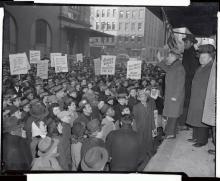In the 1930s, a new type of union, an “industrial” union that welcomed all workers in a single workplace emerged as the cutting edge of working-class struggle. Previously, unions and employers both had a long history of racism and support for white supremacy. Certain jobs were reserved for whites, and Black workers were kept out of factories and union halls. This had catastrophic consequences. For example, in the 1919 Steel Strike, employers brought in 30,000 Black and immigrant workers to break the strike staged by white workers and their racially exclusive unions. With that, employers got production moving again, defeated the strike, and prevented worker organizing for the next 15 years.
The CIO Was One of the Most Successful Anti-Racism Movements in U.S. History

In the 1930s, a new type of union, an “industrial” union that welcomed all workers in a single workplace emerged as the cutting edge of working-class struggle. Previously, unions and employers both had a long history of racism and support for white supremacy. Certain jobs were reserved for whites, and Black workers were kept out of factories and…
–
Originally Published in
